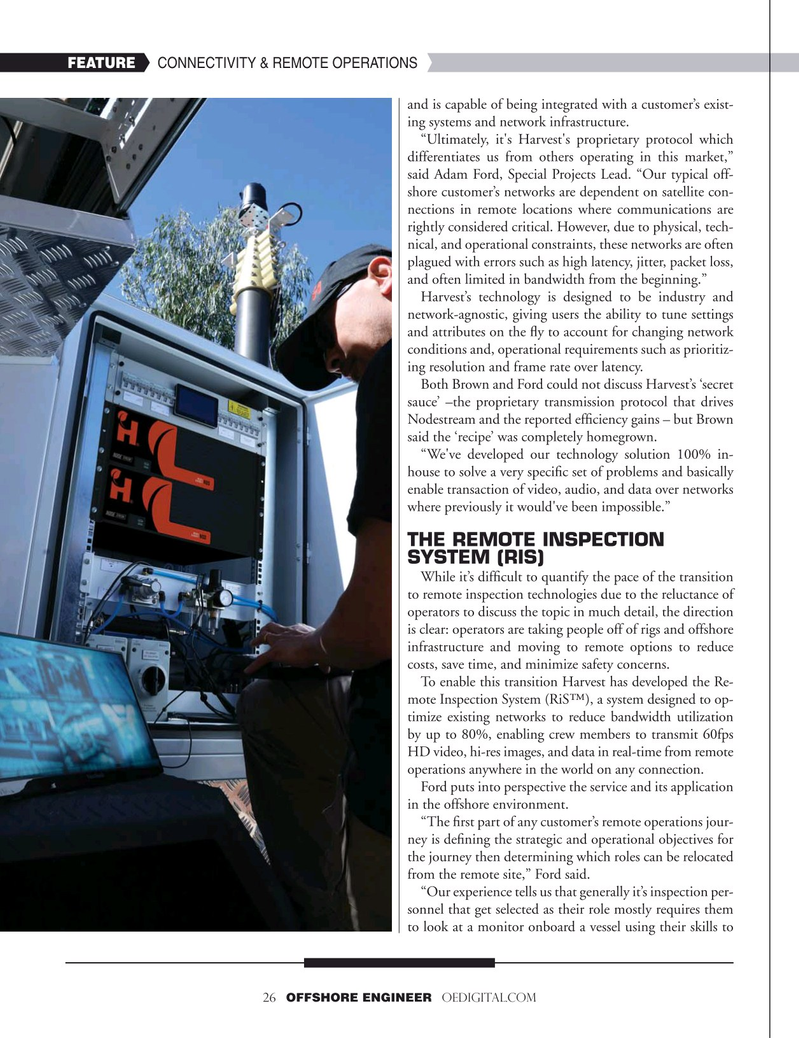
Page 25: of Offshore Engineer Magazine (Sep/Oct 2023)
Read this page in Pdf, Flash or Html5 edition of Sep/Oct 2023 Offshore Engineer Magazine
FEATURE CONNECTIVITY & REMOTE OPERATIONS and is capable of being integrated with a customer’s exist- ing systems and network infrastructure. “Ultimately, it's Harvest's proprietary protocol which differentiates us from others operating in this market,” said Adam Ford, Special Projects Lead. “Our typical off- shore customer’s networks are dependent on satellite con- nections in remote locations where communications are rightly considered critical. However, due to physical, tech- nical, and operational constraints, these networks are often plagued with errors such as high latency, jitter, packet loss, and often limited in bandwidth from the beginning.”
Harvest’s technology is designed to be industry and network-agnostic, giving users the ability to tune settings and attributes on the ?y to account for changing network conditions and, operational requirements such as prioritiz- ing resolution and frame rate over latency.
Both Brown and Ford could not discuss Harvest’s ‘secret sauce’ –the proprietary transmission protocol that drives
Nodestream and the reported ef?ciency gains – but Brown said the ‘recipe’ was completely homegrown.
“We've developed our technology solution 100% in- house to solve a very speci?c set of problems and basically enable transaction of video, audio, and data over networks where previously it would've been impossible.”
THE REMOTE INSPECTION
SYSTEM (RIS)
While it’s dif?cult to quantify the pace of the transition to remote inspection technologies due to the reluctance of operators to discuss the topic in much detail, the direction is clear: operators are taking people off of rigs and offshore infrastructure and moving to remote options to reduce costs, save time, and minimize safety concerns.
To enable this transition Harvest has developed the Re- mote Inspection System (RiS™), a system designed to op- timize existing networks to reduce bandwidth utilization by up to 80%, enabling crew members to transmit 60fps
HD video, hi-res images, and data in real-time from remote operations anywhere in the world on any connection.
Ford puts into perspective the service and its application in the offshore environment.
“The ?rst part of any customer’s remote operations jour- ney is de?ning the strategic and operational objectives for the journey then determining which roles can be relocated from the remote site,” Ford said. “Our experience tells us that generally it’s inspection per- sonnel that get selected as their role mostly requires them to look at a monitor onboard a vessel using their skills to 26 OFFSHORE ENGINEER OEDIGITAL.COM

 24
24

 26
26